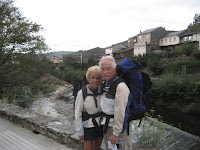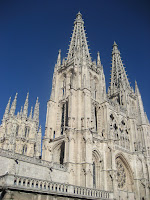
Given our long walk yesterday we decided to take the shorter route to Sarria (our destination), which was not to be. One thing we discovered was that a detail guide book is needed when taking alternate routes. Often we see yellow arrows pointing in different directions and unless there is signage we usually take the path with the more predominate markings. We had anticipated 20km today and instead we did 25km, but no regrets. We passed through the most awesome scenery – mountain streams and lush forests, and we came upon Samos with a beautifully preserved sixth century monastery and famous for its library, with a Latin motto on the door, “A cloister without a library is like a fort without and armory.” It's become routine for us to stop by mid-afternoon at a bar/cafe to have lunch, and we've often been lucky finding sunny and picturesque spots, along with other peregrinos in search of the same. See Pictures>>






























